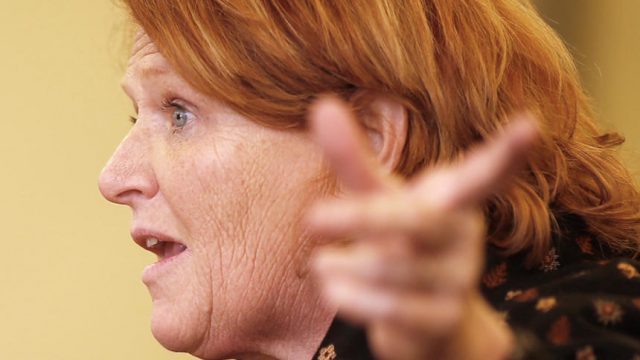Can North Dakota Democrats Get Their Voters Back From Republicans in 2018?

U.S. Sen. Heidi Heitkamp talks about the prospect of temporarily housing refugee children at the Grand Forks Air Force Base during a recent visit to the Grand Forks Herald Editorial Board. photo by Eric Hylden/Grand Forks Herald
“I’m betting on Heitkamp against any Republican opponent who’s so far been mentioned,” my friend Mike Jacobs writes today.
Senator Heidi Heitkamp, of course, is up for re-election in 2018. She hasn’t officially announced that she’s running yet, but it’s a near certainty she will given how her allies have been out attacking potential Republican challengers early and often.
On paper Heitkamp’s re-election bid looks strong. She’s raised a lot of money already (though most of it came from special interests and out of state contributors), and what little polling data is available publicly looks good for her. She’s also mostly played nice with President Donald Trump in the early days of his administration and he’s reciprocated.
The best thing to happen to Heitkamp so far in the 2018 election cycle was Trump’s very public flirtation with putting Heitkamp in his cabinet. It may have infuriated the far-left remnants of the North Dakota Democratic Party, but it burnished the incumbent’s reputation as a middle-of-the-road moderate.
Heitkamp doesn’t need the Bernie Sanders wing of her party to win elections in North Dakota. She needs the moderate Republican vote.
Here’s the thing, though. Getting that moderate Republican vote is going to be a lot harder for Heitkamp in 2018 than it was in 2012.
From 2012 to 2016 – both presidential election cycles, mind you – the Democrats saw turnout for their candidates in North Dakota decline nearly 40 percent. In the 2012 cycle, which was the last time President Barack Obama was on the ballot, Democrat candidates for the Legislature and partisan statewide office together collected over 1.16 million cumulative votes.
In 2016 that number dipped to just 702,856.
After all the votes in the 2012 cycle were tallied Republicans enjoyed a 3-2 advantage in voter turnout over Democrats. For our liberal friends, Senator Heitkamp’s narrow victory over Republican challenger Rick Berg was really the only bright spot in state-level elections.
In the 2016 cycle, however, Republicans enjoyed a 3-1 advantage in turnout.
There aren’t a lot of good explanations for this for the Democrats. Overall turnout was roughly the same. In 2016 it was just 1.5 percent – or about 44,000 votes – lower than in 2012.
One might be tempted to say that an uninspiring slate of statewide candidates for the Democrats hurt their turnout. Which seems absolutely true, but instead of staying home most of those erstwhile Democrats seem to have turned to the Republicans.
That didn’t just happen in the general election, either. In the 2016 primary the ratio of Republican voters to Democratic voters was unusually high compared to previous cycles:
I warned in June of last year that Democrats ought not be cavalier about these numbers, and I was right. Come November the Democrats suffered an election day bloodbath, getting slaughtered by Republican candidates in the statewide races and losing major ground in the Legislature to boot.
Can Democrats turn this trend around?
If anyone can do it for them it’s Heidi Heitkamp. After all, she won in 2012 despite a heavy Republican turnout advantage, but it was a tiny margin of victory, and since then North Dakota’s electorate has shifted even further in favor of Republicans.
For decades North Dakota’s Democrats have counted on ticket splitters to elect their candidates on the statewide ballot. Think back to the 2000’s when Republicans like Governor John Hoeven were winning big election victories alongside Democrats like Senator Kent Conrad and Rep. Earl Pomeroy. That happened because a big chunk of the electorate was happy to vote for both Republicans and Democrats on the same ballot.
Is that sort of thing still possible, though, in these highly polarized times?
Heitkamp better hope it is.






